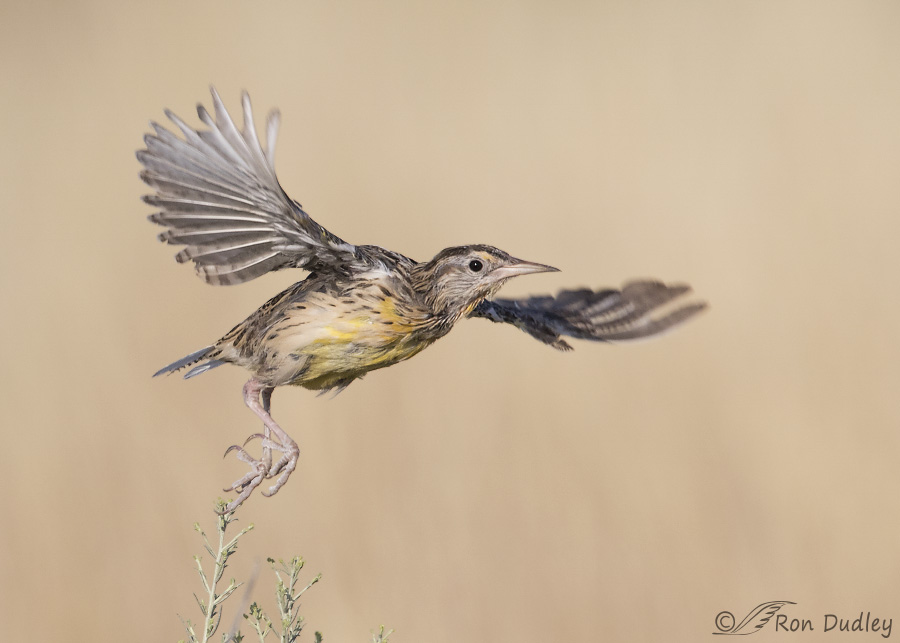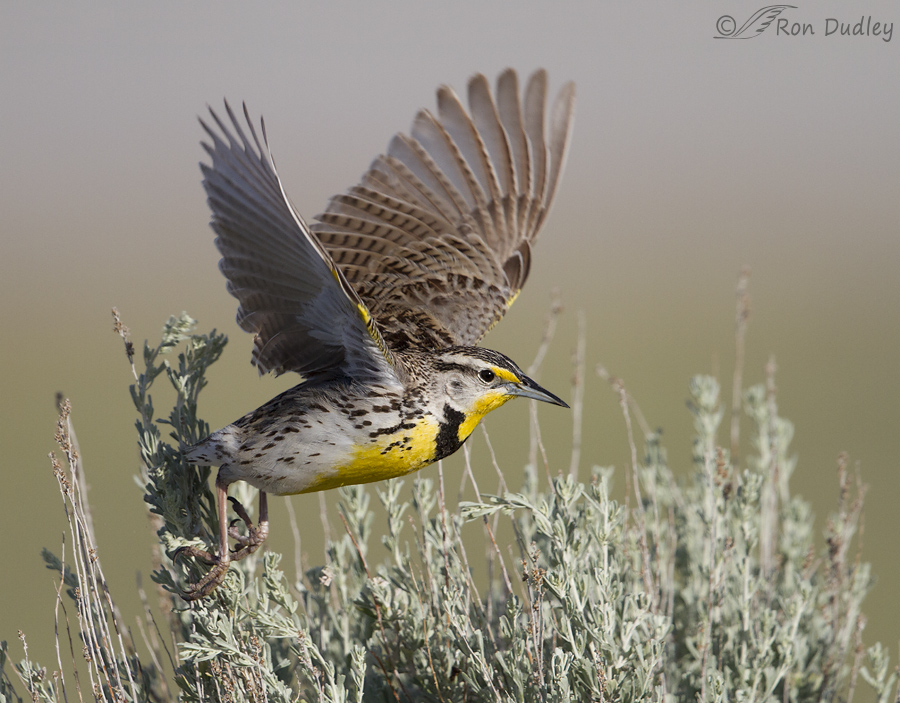The differences between juvenile and adult Western Meadowlarks often go unrecognized by observers in the field but when you see them up close through a lens those differences become striking.
 1/4000, f/6.3, ISO 500, Canon 7D Mark II, Canon EF 500mm f/4L IS II USM + 1.4 tc, not baited, set up or called in
1/4000, f/6.3, ISO 500, Canon 7D Mark II, Canon EF 500mm f/4L IS II USM + 1.4 tc, not baited, set up or called in
Three days ago my first trip to Antelope Island after the fire was mostly a bust for bird photography. Except for the weasel I photographed as I left the island this young Western Meadowlark was my only cooperative subject. This bird seems to be quite young and probably very recently fledged. I like to photograph birds in all stages of development and plumage conditions so I was happy to get this image taken soon after the bird lifted off from sagebrush.
I like the takeoff posture, the position of those large feet and legs, the light on the bird overall, the clean, slightly wispy background and the excellent eye contact.
From a distance this bird would appear to many to be “just” another adult meadowlark in sage but notice that it lacks the black V-shaped band on the breast and the vibrant colors and bold face pattern of the adult. And to my eye its plumage appears to have a soft, silky appearance that I don’t see in adults.

1/3200, f/6.3, ISO 500, Canon 7D, Canon EF 500mm f/4L IS USM + 1.4 tc, not baited, set up or called in
Here’s an adult in a similar pose for contrast. Up close like this I think the differences between adult and young juvenile are striking.
John James Audubon gave the Western Meadowlark its scientific name, Sturnella neglecta – neglecta because he thought early settlers and explorers had overlooked this common bird and Sturnella because of its similarity to starlings. I’m not fond of that comparison because I’ve never been a big fan of starlings and that opinion was reinforced last week when a young starling fell down the vent of the furnace in my home and ended up in the ductwork. Its claws on the ductwork sounded like there was an angry Tasmanian Devil caught in the furnace and I spent half of a day tearing the furnace apart to get it out. I was not a happy camper.
But in the end I released the starling (minus all of its tail feathers) and it flew off to cause more mischief.
Ron
Note: My disparagement of starlings was mostly tongue in cheek – after all it’s not their fault they’re here…


Ron, thanks for rescuing the starling. Sort of bedraggled I bet. Guess not many of us are truly “native” but guess depends on ones definition. I would never have recognized the fledgling without your explanation. And thanks forthephotos
Beautifully detailed shots Ron and great observations!
Charlotte
Love the striking differences your photos show.
We have problems with quite a number of introduced species here too. Our fault.
Yup, seems to me that Australia is well-known for a number of problematic introduced species, EC. But we’ve all got-em.
That’s a great comparison, Ron! I got lucky the other day and saw three Eastern Meadowlarks feeding together. As you said, from a distance they all looked like adults. Through binoculars it was easy to distinguish the juvenile bird.
Thank you for providing continuing education.
Thanks very much, Wally.
That is a young fledgling. It still has pin feathers on it’s neck and face. It’s tail is still short, the wings have not filled in and it has the adorable baby look in it’s face.I wish it a long and healthy life.
April, Once I saw how young it was I was just a little surprised that it could actually fly.
Hi Ron, you are probably aware of this, but perhaps some of your followers might be interested to know the much maligned Starling is an intelligent bird. Here is the first paragraph of an article on their “speech” patterns from the University of Chicago:
“Uniquely human” component of language found in gregarious birds.
Although linguists have argued that certain patterns of language organization are the exclusive province of humans — perhaps the only uniquely human component of language — researchers from the University of Chicago and the University of California San Diego have discovered the same capacity to recognize such patterns and distinguish between them in Sturnus vulgaris, the common European starling.
here is the full article:
http://www-news.uchicago.edu/releases/06/060426.starling.shtml
Interesting article, Brett – thank you. I’ve read some other things on starling “speech” too.
Diane O. used to call starlings “rubber band birds” because some of their complex vocalizations sounded like a taut rubber band being “twanged”.
I call the “the Mafia” and other things that you would NOT want to print…
I keep learning. …. Thank-you.. I for one have excepted the starlings they are here to stay… And cause me less grief than ..Sharp shin who is always catching my innocents. Ate my kingbird babies .. ( I was yelling at him and throwing stuff) Magpies stealing eggs. … It’s all about survival.
Yep, everything has to eat, Marina…
Bet you have a screen on that vent now! Nice shots – the juvenile looks a bit skinny to me but the comparisons next to each other do show the differences. On pests – I thought a magpie family in the yard was bad – a family of grackles is right up there!
Nice shots – the juvenile looks a bit skinny to me but the comparisons next to each other do show the differences. On pests – I thought a magpie family in the yard was bad – a family of grackles is right up there! 
“Bet you have a screen on that vent now!”
Boy, you’ve got that right, Judy. There was already a cone-shaped hood over it but the starling apparently hooked its claws on the upper edge of the vent opening, climbed in and then fell. Yes, I’ve added some wire screen…
To me, the first shot looks like a juvenile bird, I guess because of the sort of camouflage-colored plumage. And because it looks like its feathers are not fully developed. It just has a juvenile look about it. I hear you about Starlings! There are some gorgeous ones in other parts of the world, but they are still Starlings…
Agreed, Susan. Up close this bird almost screams “juvenile”. But from a distance the difference isn’t nearly so obvious.
Very interesting contrast Ron. It also looks like the juvenile hasn’t yet filled in its wings with the close-to-the-body tertiary wing feathers, although it’s possible they might be hidden with the position of the wings at takeoff. After all, juveniles grow all their feathers at the same time–the ONLY time they do that in their lives. I’ve told my British friends to take them all back, but they don’t want them either! LOL!
I’ve told my British friends to take them all back, but they don’t want them either! LOL!
As for the starlings, in my world, they’re hawk food
I wondered the same thing about those wing feathers, Laura, but in the end I decided they’re probably there – just hidden from view by their uplifted angle.